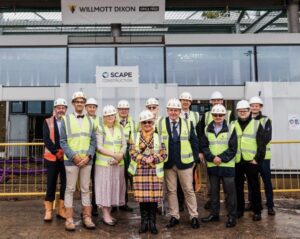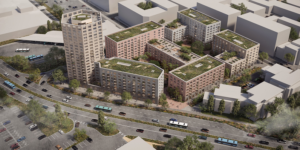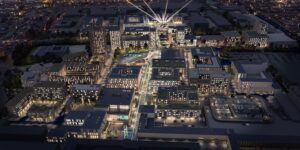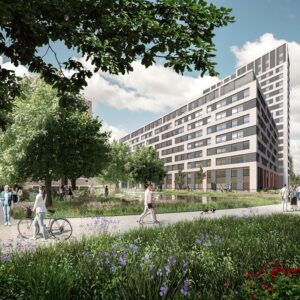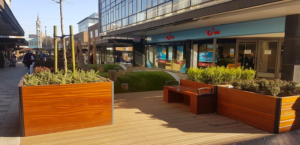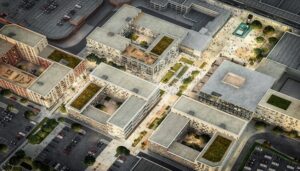The event was attended by representatives from Stevenage Borough Council, Hertfordshire Local Enterprise Partnership (LEP), and contractors Willmott Dixon. A ‘topping out’ ceremony is traditionally held once the last beam has been placed on top of a new construction in the building trade.
Work started on the project in late 2020, part-funded by a £9.6m Local Growth Fund investment from Hertfordshire LEP, with Willmott Dixon working ahead of schedule to complete the first stages of the transport hub. The development will drastically improve transport links across the town, provide wider accessibility and align with the newly-regenerated Town Centre. Works on the interchange should be completed in the coming months with services commencing thereafter.
The interchange features an extensive canopy with a large glazed screen and automatic doors for easy passenger access. It also includes a passenger facilities building which provides a waiting area with extensive seating, live passenger information boards, a café kiosk and public conveniences as well as greatly-improved accessibility features.
External works include a new high-quality connection linking the bus interchange, town square and the train station ensuring a clear connection between the existing cycle network and bus and rail networks and providing integrated links between Stevenage’s main transport hubs.
Cllr Sharon Taylor OBE, Leader of Stevenage Borough Council said:
“We are delighted to carry out this ceremony with our partners and to see the incredible progress that Willmott Dixon has made on such a key project. The interchange is a pivotal part of the early stages of our ongoing 20-year regeneration programme, and, when open, will provide a massive improvement on the existing setup.”
Cllr John Gardner, Executive Portfolio Holder for Regeneration & Environment at Stevenage Borough Council, added:
“The new interchange will offer a boost to the town at a time when we’re all looking to push forward following the impact of the pandemic. It links more effectively with the newly expanded railway station and will enable a new Garden Square to be delivered at the location of the old site. This is a really exciting time for Stevenage and we’re very happy to meet with our partners today, all of whom have been integral to the success of our regeneration programme.”
“We are delighted with the progress made to date on the new interchange” commented Adam Wood, Head of Infrastructure & Regeneration at Hertfordshire LEP, “which will not only improve connectivity and transport links within Stevenage but also provide an attractive gateway for visitors that befits the redeveloped Town Centre. The scheme forms a key part of our £34m Local Growth Fund investment towards the town’s regeneration, set to help bring forth new homes, public amenities, and retail and business space to maximise the town’s economic potential.”
Chris Tredget, Managing Director at Willmott Dixon concluded:
“It’s fantastic to be able to celebrate the ‘topping out’ of Stevenage’s new Bus Interchange and all of the progress made so far. Once completed, the project will make a real difference to the transport links in the town and we’re proud to be working alongside Stevenage Borough Council and Hertfordshire LEP to deliver the first stage of the town’s regeneration programme.”
